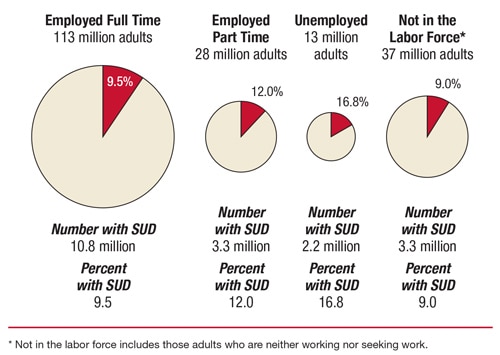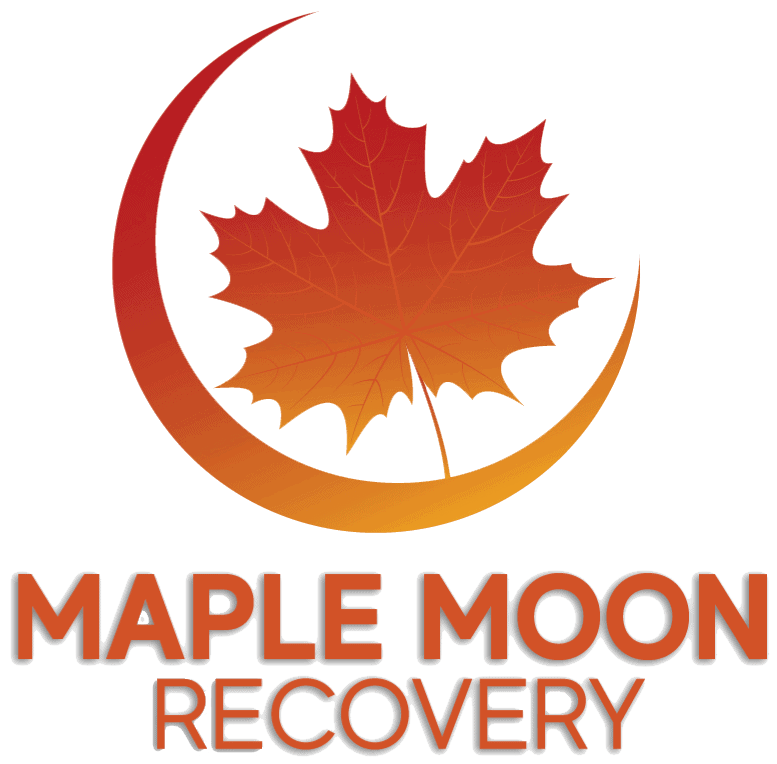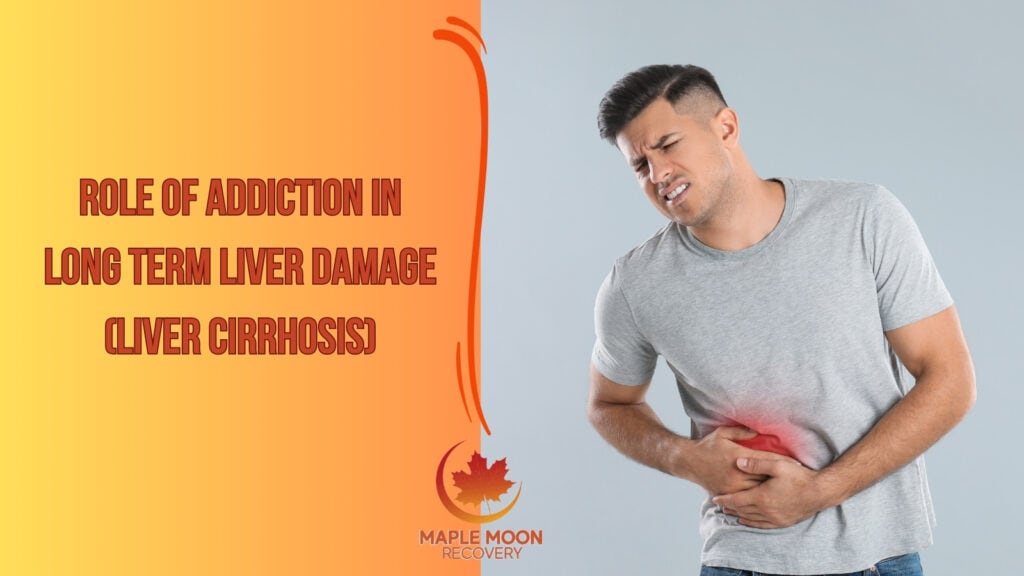Key Takeaways:
- Understanding the risk factors for substance abuse in the workplace is crucial in identifying and addressing the problem. These risk factors include high-stress jobs, easy access to drugs or alcohol, and a culture that tolerates substance abuse.
- Recognizing common indicators and warning signs of substance abuse can help managers and coworkers identify and support struggling employees. These symptoms include changes in behavior, absenteeism, and poor job performance.
- To address substance abuse in the workplace, employers should establish and communicate clear policies, provide support through an employee assistance program, and recommend drug rehab providers for recovery. Proactively preventing substance abuse includes creating a supportive work environment and providing education and resources to employees.
What Is Substance Use Disorder?
Substance Use Disorder (SUD) is a medical condition characterized by an individual’s recurrent use of drugs or alcohol that causes significant clinical and functional impairment. This impairment may be expressed as health problems, disability, and failure to meet significant responsibilities at work, school, or home. The term “Substance Use Disorder” is often used interchangeably with other terms like addiction, drug abuse, alcoholism, chemical dependency, and substance misuse.
Substance Use Disorder is diagnosed based on evidence of impaired control, social impairment, risky use, and pharmacological criteria. It covers a wide range of substances including alcohol, cannabis, hallucinogens, inhalants, opioids, sedatives, hypnotics, anxiolytics, stimulants, tobacco, and other (or unknown) substances. The severity of the disorder (mild, moderate, or severe) is based on the number of diagnostic criteria met by an individual.
In the workplace, Substance Use Disorder can lead to a multitude of problems. From an employer’s perspective, it can affect productivity, safety, and the overall work environment. Employees who are under the influence or withdrawing from drugs or alcohol may have impaired judgment or physical ability, leading to accidents or mistakes on the job. Additionally, they may have increased absenteeism or tardiness, lower job performance, and possibly even increased healthcare costs.
For employees suffering from a Substance Use Disorder, it may not only affect their work performance, but also their relationships with colleagues and supervisors. They may face stigma and discrimination, potentially leading to job loss, which can exacerbate the problem. Furthermore, stress and pressure from work can also contribute to the onset or worsening of Substance Use Disorder, creating a vicious cycle.
As such, it is essential for employers to create a supportive work environment that encourages employees to seek help if needed, and to provide access to resources and programs that assist in recovery. Employers can also promote preventive measures, such as stress management, and implement policies that discourage substance abuse while protecting the rights and confidentiality of employees.
Addiction and the Workplace: Understanding Substance Abuse in the Workplace
When it comes to the issue of addiction in the workplace, understanding the root causes and identifying risk factors are crucial in recognizing and addressing substance abuse on the job. In this segment, we will explore how substance abuse can take a toll on an individual’s professional life, and why it is important to recognize the warning signs of addiction. We’ll also take a closer look at defining substance abuse and addiction, and identify risk factors that could lead to substance abuse in the workplace. By gaining a better understanding of these key issues, we can work towards creating healthier and more productive working environments for everyone involved.
Identifying Risk Factors for Substance Abuse in the Workplace
Identifying Risk Factors for Substance Abuse in the Workplace is essential to understand how addiction can affect employees and their workplace. Substance abuse in the workplace can lead to decreased productivity, absenteeism, injuries, accidents, and turnover rates.
Risk factors for substance abuse in the workplace include personal factors such as stress, anxiety, depression, and trauma. They may also stem from social factors such as peer pressure or cultural norms that encourage substance use. Workplace environment factors may also contribute to substance abuse; these include long working hours or a lack of social support from coworkers.
It is important to note that individuals with pre-existing mental health conditions are at an increased risk of substance abuse in the workplace. Additionally, access to drugs may increase the likelihood of developing a substance use disorder.
Studies show that access to employee assistance programs (EAP) can reduce the likelihood of workplace substance abuse. Additionally, interventions such as offering education on healthy coping mechanisms for work-related stressors can create a supportive and proactive work environment.
Next to the family, the workplace is probably the most important setting for shaping and constraining alcohol and other drug-related expectations and behavior
The consequences of workplace substance abuse are well documented throughout history – airline companies have lost millions due to pilots under the influence of drugs while on flights. The high demand coupled with job stress led some pilots down this path. The incident has had severe implications that led to regulatory frameworks also being established around it.
Spotting Substance Abuse in the Workplace
As an employer or colleague, it is critical to recognize the signs of substance abuse in the workplace. By addressing these issues head-on, we can create a safer and more productive work environment for all. In this section, we’ll explore the various indicators of substance abuse and the different warning signs to look out for. By understanding these key signs, managers and colleagues can better spot instances of substance abuse and provide the necessary support and resources for those affected. And according to a recent study by the National Safety Council, workplace drug overdose deaths have increased by 536% in the United States since 2011, making this issue more important than ever before.
Workplace unintentional overdose deaths from nonmedical use of drugs or alcohol have increased 536% since 2011. Overdose deaths totaled 464 in 2021, equivalent to nearly 9% of all occupational injury deaths in 2021″
Recognizing Common Indicators of Substance Abuse
Recognizing common indicators of substance abuse is a crucial step towards addressing addiction in the workplace. Some of these indicators include changes in an individual’s behavior or mood, sudden absences or tardiness, and unexplained financial difficulties. Additionally, visible physical symptoms such as bloodshot eyes, frequent sniffing, and tremors can also indicate substance abuse.
It’s important to understand that recognizing common indicators of substance abuse requires observation and careful understanding of an individual’s behavior patterns. For example, if someone who was always punctual suddenly starts showing up late or missing work altogether, it could be a sign of drug or alcohol abuse. Similarly, unexplained absences combined with mood swings can be another indicator.
Other red flags include changes in one’s social circles or withdrawing from previous activities and interests. A person who was once energetic and outgoing but has now become more distant may be struggling with addiction. Changes in appearance, hygiene, and grooming habits are additional signs of possible substance abuse.
One way to recognize indicators of substance abuse is by initiating a conversation with your coworkers that stems from genuine concern for their well-being. It’s important to listen actively when speaking with someone you suspect may be suffering from addiction. You might offer mental health resources available through your company’s employee assistance program (EAP), connect them to community resources like anonymous meetings or counseling services nearby as well as medical detox services when appropriate that specialize in addressing addiction.
If you observe these signs repeatedly over time or they appear quite drastically, make sure to address this matter quietly and directly with HR managers or supervisors at your work environment before confronting the individual on this subject.
Noticing Warning Signs of Substance Abuse
Noticing Warning Signs of Substance Abuse in the workplace could be difficult, but it is a significant aspect that deserves much attention. As a responsible employee or employer, recognizing these signs can aid in preventing addiction before they become severe problem.
Here are six warning signs that indicate substance abuse: sudden mood shifts, unexplained absences or tardiness, physical changes in appearance, lower productivity and performance levels, increased agitation and difficulty focusing on tasks. Note that recognizing the symptoms early fosters understanding rather than confrontation while addressing the matter effectively.
Substance addiction thrives on secrecy; many employees may display addictive behavior patterns without letting others know. They may have legal prescriptions for medication to handle an underlying issue but may misuse it to ‘feel better.’ Valuable information such as this helps one understand why noticing behavioral changes could address addiction from its root cause.
As individuals with various roles both at work and at home, we must pay close attention to people’s behavioral traits who might be experiencing drug addiction. We never know what other contributions they make towards our company’s growth and how much value they add to our lives even outside the office walls. Moreover, if left unattended by peers and subordinates alike, things could spiral into uncontrollable vices at different stages of work-life engagement.

Looking out for those around us should be our primary goal in every aspect of life. Only then can we achieve a healthy working balance and prevent dependency issues from taking hold. However complex this task may seem, it is easy to master with constant practice- hence the need to learn about addressing substance abuse in the workplace.
It is vital that we stay alert at all times as we explore ways to address potential addiction hazards amongst ourselves and others.
Addressing and Tackling Substance Abuse in the Workplace
A comprehensive substance abuse policy can help organizations effectively address and tackle substance abuse in the workplace. It is increasingly becoming essential due to the rise in drug and alcohol abuse among employees, which has led to productivity issues, safety concerns, and an increase in medical costs.
Establishing a Comprehensive Substance Abuse Policy involves defining the objectives of the policy, identifying the consequences of violating it, designing a program for testing employees regularly, creating guidelines for addiction treatment for affected employees, and ensuring there are confidentiality policies in place. A properly implemented program reduces absenteeism, ensures compliance with regulations and standards, helps create a safer work environment while fostering employee wellbeing.
A good Comprehensive Substance Abuse Policy should be implemented consistently across all levels of the organization. Policies that only target front-line employees are ineffective as top executives are often responsible for initiating it. For instance, The National Institute on Drug Abuse (NIDA) developed an organizational-level approach called “The Baldrige Framework” that businesses use to assess substance-abuse programs’ effectiveness.
According to a study by SAMSHA in 2019, about 10% of full-time employees consume illicit drugs either at work or during working hours nationwide.
Workplace Addiction Statistics
Workplace addiction is a significant issue that can impact productivity, safety, and the overall work environment. It refers to the situation where an employee is unable to control their use of substances, such as alcohol or drugs, leading to a negative impact on their job performance and relationships at work. This can manifest in various ways, including frequent absences, decreased productivity, increased risk of accidents, and conflicts with colleagues. It’s important for employers to recognize the signs of addiction and provide support and resources for employees struggling with substance abuse. This can include implementing workplace policies, providing education about the dangers of substance abuse, and offering assistance programs to help employees seek drug rehab. Addressing workplace addiction not only improves the health and well-being of employees but also contributes to a more productive and harmonious work environment.

- Data from the 2008 to 2012 National Survey on Drug Use and Health (NSDUH) shows that adults aged 18 to 64 who were unemployed were more likely than those in other employment groups to have had a past year substance use disorder.
- About three-fifths of the U.S. population aged 18 to 64, or 113.1 million people, are full-time workers. Consequently, most adults with substance use disorders are employed full-time (55.1 percent).
| Employment Status | Number of Adults | Number with SUD | Percent with SUD |
|---|---|---|---|
| Employed Full Time | 113 million | 10.8 million | 9.5% |
| Employed Part Time | 28 million | 3.3 million | 12.0% |
| Unemployed | 13 million | 2.2 million | 16.8% |
| Not in the Labor Force* | 37 million | 3.3 million | 9.0% |
What Is An Employee Assistance Program For Addiction?
An Employee Assistance Program (EAP) is a workplace-based program or set of services designed to assist employees in resolving personal problems that might adversely impact their work performance, health, and overall well-being.
EAPs generally offer free and confidential assessments, short-term counseling, referrals, and follow-up services for employees. These programs may cover issues such as:
- Mental Health: EAPs often offer services to help manage issues like stress, depression, anxiety, and grief.
- Substance Abuse: These programs typically offer resources for coping with substance abuse issues, both for employees struggling personally and for those concerned about a coworker or family member.
- Workplace Issues: This can include conflict resolution services, stress management related to work, handling workplace changes, and so on.
- Personal Issues: Many EAPs also cover non-work related issues that can affect an employee’s performance, like divorce, death of a loved one, financial or legal troubles, and more.
- Crisis Management: Some programs provide immediate, emergency psychological support in the event of a crisis, such as a natural disaster, serious accident at work, or violent incident.
- Work-Life Balance: EAPs might offer services related to maintaining a healthy work-life balance, including parenting advice, eldercare assistance, and time management skills.
EAP services are usually available to employees and often their families 24 hours a day, seven days a week. They are intended to be a proactive measure, helping employees cope with issues before they become larger problems that affect work performance.
While EAPs provide valuable resources, it’s important to note that they are typically designed for short-term support and are not a substitute for more intensive or specialized psychological or medical care. If the EAP determines that an employee’s issue is beyond its scope, they will usually refer the employee to an appropriate outside resource or specialist.
Employee assistance programs have proven to be not only helpful but necessary for the success of any business. Implementing an effective employee assistance program involves providing your employees with access to counseling, resources, and support that can aid in their overall well-being. These programs can be customized to suit the specific needs of your organization, making them both adaptable and efficient.
Employee assistance programs are designed to help individuals facing various life challenges such as substance abuse, mental health issues, financial problems, and relationship conflicts. Programs like these provide a safe space for employees where they can receive confidential and non-judgmental support. Research has shown that such programs significantly reduce absenteeism and promote better workplace safety by helping workers overcome personal issues.
What Are Examples of Different EAP Programs For Substance Use Disorder?
Employee Assistance Programs (EAPs) provide support and services for employees dealing with personal problems, including substance abuse. They are designed to help employees overcome these issues and continue to be productive at work. Here are a few examples of such programs:
- Federal Employee Assistance Program (FedEAP): This EAP provides confidential, voluntary, and professional assessment, counseling, referral, and follow-up services for federal employees dealing with substance abuse, among other personal issues.
- The Substance Abuse and Mental Health Services Administration (SAMHSA): While not strictly an EAP, SAMHSA provides resources and guidance that businesses can use to create their own EAPs for dealing with substance abuse.
- Magellan Healthcare EAP: Magellan’s EAP provides services to employees and their families facing substance use issues, offering a range of resources from counseling to digital cognitive behavioral therapy programs.
- ComPsych EAP: ComPsych’s program offers a broad range of services, including substance abuse support, with a focus on confidentiality and accessibility.
- CuraLinc Healthcare EAP: This program provides personalized and confidential services for employees dealing with substance use disorders. Services include assessment, short-term counseling, and referral to appropriate treatment resources.
- Physicians Health Network (PHN): This EAP is specifically tailored to physicians and medical practitioners, offering support, resources, and treatment options for those struggling with substance abuse.
- Flight Attendant Drug and Alcohol Program (FADAP): FADAP is a unique EAP tailored to flight attendants, providing peer support, education, and resources for those dealing with substance use disorders.
- Lawyers Assistance Program (LAP): This is a service provided by various state bar associations in the United States to offer help to lawyers, judges, and law students who are struggling with substance abuse, stress, or mental health issues.
- ABA Commission on Lawyer Assistance Programs (CoLAP): This is an American Bar Association program dedicated to educating the legal profession about mental health and substance use disorders. It provides resources and support to legal professionals dealing with these issues.
- Lawyers Concerned for Lawyers (LCL): This is a program available in several states that offers confidential help to lawyers, judges, law students, and their families dealing with alcoholism, substance use disorders, or mental health issues.
- Occupational Health Consulting (OHC) Lawyers Assistance Program: OHC offers a confidential service designed specifically for law firms. The program provides a full range of assistance, including counseling, crisis intervention, referral, and continuing care monitoring.
Remember that these programs can be very helpful, but they are not a substitute for professional medical advice. If you or someone you know is struggling with substance use, please reach out to a healthcare provider.
Addiction Treatment Programs For Employees

Addiction treatment programs for employees are designed to help individuals struggling with substance abuse issues recover while maintaining their employment status. These programs are typically comprehensive, addressing the physical, psychological, and social aspects of addiction.
Here’s a breakdown of the key components:
- Detoxification: The first step in many addiction treatment programs is detoxification, which involves clearing the body of the substance of abuse. This process can be medically supervised to manage withdrawal symptoms, which can be severe for some substances.
- Inpatient Rehabilitation: For severe addictions, employees may need to take a leave of absence to attend an inpatient rehab program. These programs provide 24/7 care and support, including medical supervision, counseling, and therapy. The goal is to stabilize the individual’s health and start addressing the underlying issues related to their addiction.
- Outpatient Rehabilitation: For those with less severe addictions or who have already completed an inpatient program, outpatient rehab allows individuals to receive treatment while continuing to work. These programs typically involve regular therapy sessions and may also include medication management.
- Therapy and Counseling: Both inpatient and outpatient programs typically involve individual and group therapy. Cognitive-behavioral therapy (CBT) is commonly used to help individuals understand the triggers of their addiction and develop coping strategies. Other therapeutic approaches may include motivational interviewing and family therapy.
- Aftercare and Recovery Support: After completing a rehab program, ongoing support is crucial to maintain recovery and prevent relapse. This can include continued therapy, support groups, and recovery coaching. Some programs also offer vocational support to help individuals return to work successfully.
- Medication-Assisted Treatment (MAT): For some types of addiction, medication can be used to manage withdrawal symptoms, reduce cravings, or treat co-occurring mental health issues. This is often combined with therapy and counseling for a comprehensive approach to treatment.
Remember, the most effective programs are tailored to the individual’s specific needs and circumstances. It’s also important for employers to provide a supportive environment that enables employees to seek help without fear of stigma or job loss.
Take Action Now: Help Is Available
In the face of a substance use disorder, every action counts. Whether you are someone seeking help, a family member, a friend, HR professional or a co-worker, your involvement can make a world of difference. Maple Moon Recovery is committed to combating the opioid crisis, but we can’t do it alone. We need a united community, ready to take a stand, support one another, and work towards a future free from the devastation of opioid addiction. Don’t wait for change – be the change. Reach out to Maple Moon Recovery today to find out how you can contribute to this vital cause or seek the help you or a loved one needs.
Sources:
- Miller, N. S., and Gold, M. S. “Comorbidity of Psychiatric and Substance Use Disorders in the United States: Impact on Differential Diagnosis and Treatment.” Journal of Psychiatric Treatment and Evaluation, vol. 14, no. 4, 1992, pp. 417-426. PubMed, https://pubmed.ncbi.nlm.nih.gov/1405640/.
- “The Nature and Extent of the Problem.” Substance Abuse: A Comprehensive Textbook, 4th ed., edited by Joyce H. Lowinson et al., Lippincott Williams & Wilkins, 2005, https://www.ncbi.nlm.nih.gov/books/NBK236249/.
- Overdose Deaths.” National Safety Council, 2023, https://injuryfacts.nsc.org/work/safety-topics/overdose-deaths/.
- Substance Abuse and Mental Health Services Administration. (2014). Substance Use and Substance Use Disorder by Industry. Retrieved June 28, 2023, from https://www.samhsa.gov/data/sites/default/files/NSDUH-SP132-FullTime-2014/NSDUH-SP132-FullTime-2014.htm




